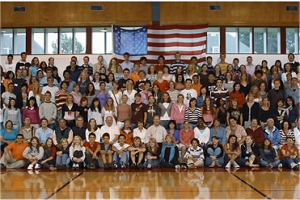Vice Versa
Foreign Students Enhance Global Outlook at U.S. High School

Washington International School offers broad exposure to many cultures
Washington -- Every year, high schools across the United States welcome foreign-exchange students into their classrooms, but at Washington International School (WIS), the student body itself is a microcosm of the global community -- and WIS exchange students further enhance the cosmopolitan mix.
An independent, private institution that educates children from pre-kindergarten through 12th grade, WIS draws “about 50 percent” of its students from “families that are longtime residents of the Washington area,” according to Kate Meenan-Waugh, director of global initiatives and service learning at WIS. The rest of the students mostly are the children of diplomats or World Bank and Inter-American Development Bank officials, she told USINFO.
Students, parents and faculty at WIS represent a total of 99 countries, so the students are accustomed to meeting and interacting with people of different backgrounds, said Meenan-Waugh. WIS also brings in two foreign-exchange students annually, recruited through the American Secondary Schools for International Schools and Teachers (ASSIST) program.
ASSIST, a nonprofit educational and cultural exchange organization, accepts applications from outstanding students all over the world, “and we request students from certain regions that are not usually represented” at WIS, Meenan-Waugh said. For the 2007-2008 academic year, WIS has enrolled foreign-exchange students from Moldova and China.
INTERPLAY OF CULTURES AND TRADITIONS
WIS exchange students enter the 11th grade when they arrive, and they live with host families whose children attend the school. Typically, the exchange students have not visited the United States before, so their WIS experience is usually their introduction to American life and the U.S. education system, Meenan-Waugh said.
“Most of them adjust very well,” she said. “They come with a certain eagerness; they’re open to new environments and experiences.” Because they are academically accomplished and can speak English, “they hit the ground running” once they begin classes at WIS, she observed. The exchange students follow the same curriculum as their WIS peers, and they contribute to the lively interplay of cultures, traditions and ideas for which the school is known.
The foreign-exchange program benefits everyone at WIS, said Meenan-Waugh. Students who have been attending an international school for years “can become very complacent and smug, thinking that they already know what it means to be from somewhere else,” but they inevitably learn a great deal from their new classmates. And exchange students often find that their preconceived notions about the United States -- and about Americans -- are inaccurate.
“One [exchange] student assumed that the math course would be easy because she’d heard that math is not too rigorous” in U.S. schools, Meenan-Waugh recalled. However, the Socratic approach to lessons at WIS -- which involves posing thoughtful questions that help students develop critical thinking skills -- disconcerted the girl “for the first couple of months. But once she got used to it, she loved it.”
Because WIS has fewer than 900 students, “our class sizes are relatively small,” Meenan-Waugh said. The largest classes generally have no more than 20 students, and some English classes have only four or five students. As a result, students receive plenty of individual attention from teachers, which is a novelty to foreign-exchange students accustomed to crowded, impersonal classrooms, said Meenan-Waugh. WIS exchange students “tell us that they enjoy getting to know their teachers and having close friendships with them. They’re surprised to see teachers coaching sports teams and being very involved in the life of the school.”
EDUCATION OF “WELL-ROUNDED INDIVIDUALS”
Many exchange students develop lasting friendships with their peers at WIS and with their host families. “They often stay in touch,” said Meenan-Waugh.
“Some will apply to U.S. universities, too,” even if they must rely on financial aid to pursue a U.S. degree, she added.
WIS offers a liberal-arts education designed to produce “well-rounded individuals,” described by the school as “athletes who perform in the school musical, artists who excel as scientists, calculus students who read Cervantes in the original language.”
A commitment to intellectual curiosity, global citizenship and reciprocity starts early, according to Meenan-Waugh. In addition to hosting annually two 11th-grade foreign-exchange students for the entire academic year, WIS has developed a short-term exchange program for its middle-schoolers. “Our 8th-graders spend 10 days in exchanges in target countries, where they speak the languages they’ve been studying in school,” Meenan-Waugh explained. “Later, the kids will host a student from one of the families they stayed with.”
Foreign-exchange students have been overwhelmingly positive in assessing the WIS program, and their presence reinforces the school’s international focus. “These students,” said Meenan-Waugh, “are an essential part of our school community.”
More information about WIS is available on the school’s Web site. To learn about the application process for student and teacher exchange programs, visit the ASSIST Web site.